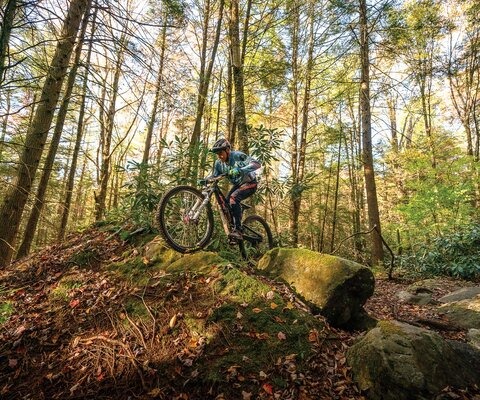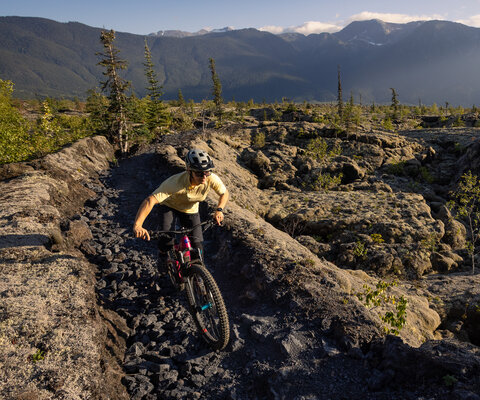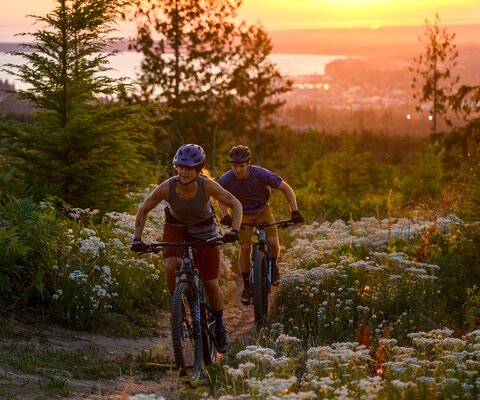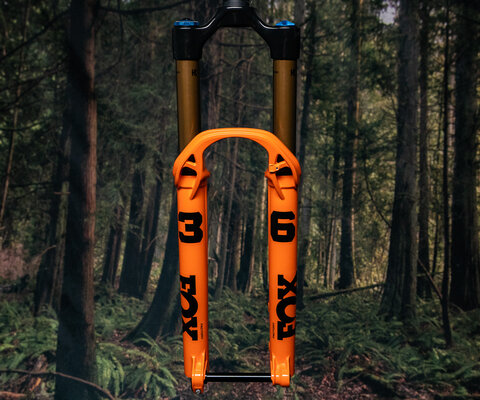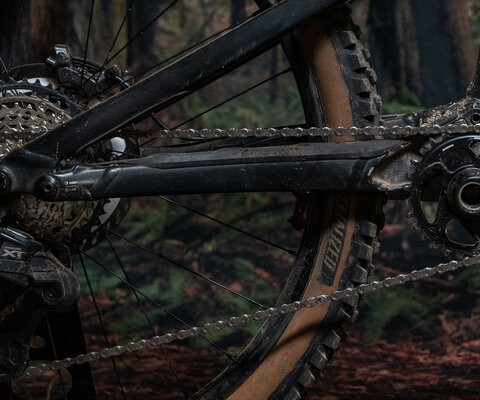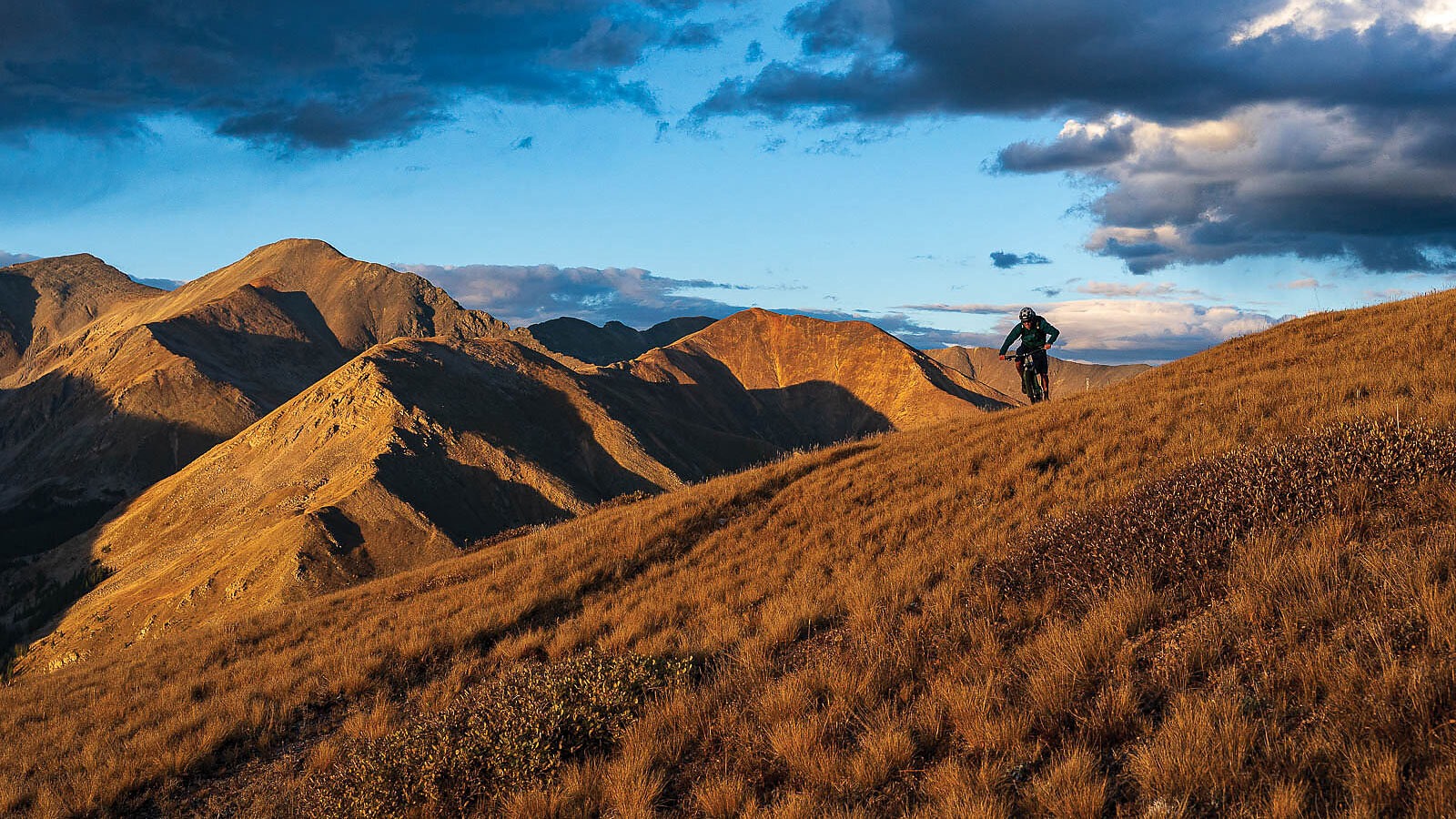
Hallowed Ground Breckenridge’s Backyard Trail Bounty
Words by Devon O'Neil | Photos by Liam Doran
It’s a Thursday morning in late September, and Nate Hills is eyeing the 69er—the biggest and most imposing launching pad at the Frisco dirt jumps. “Looks blasty today,” he says with an espresso-fueled glint in his eye.
Hills, a 46-year-old “internet-famous Colorado mountain biker,” as he describes himself, gets paid to make riding look fun. Having trails that make riding look fun is a necessity, hence the 26 years he’s spent living in Summit County. Hills is best known for charging down natural roller coasters, but Frisco’s dirt jumps are one of his sanctuaries when he’s not traveling, which takes up half his year. In recent seasons the jumps, built and maintained by the Town of Frisco in the shadow of 12,805-foot-tall Peak 1, have become an unlikely draw in an area revered for its alpine bliss and forested flow. At the annual jump jam two weeks ago, more than 200 riders descended on Frisco, many of them having driven from as far away as California.
“I pretty much ride here every afternoon when I’m in town,” says Hills, sporting a dark mustache and weathered knuckles and nursing a sprained thumb. “This is my social outlet. I wish I had this growing up.”
Hills came to Colorado in 1996 after a childhood spent in Walpole, Massachusetts. He joined the pro downhill circuit in 2003, won some races, and earned a top-three national ranking over the next decade, and signed a sponsorship agreement with Colorado-based Yeti Cycles. He rarely competes anymore and could probably satisfy his riding needs in any number of towns around the West. However, his choice of locality still says something about the area’s mountain biking. In a state full of meccas, there is something unique about north-central Colorado—in particular the zone stretching from Breckenridge to Montezuma.
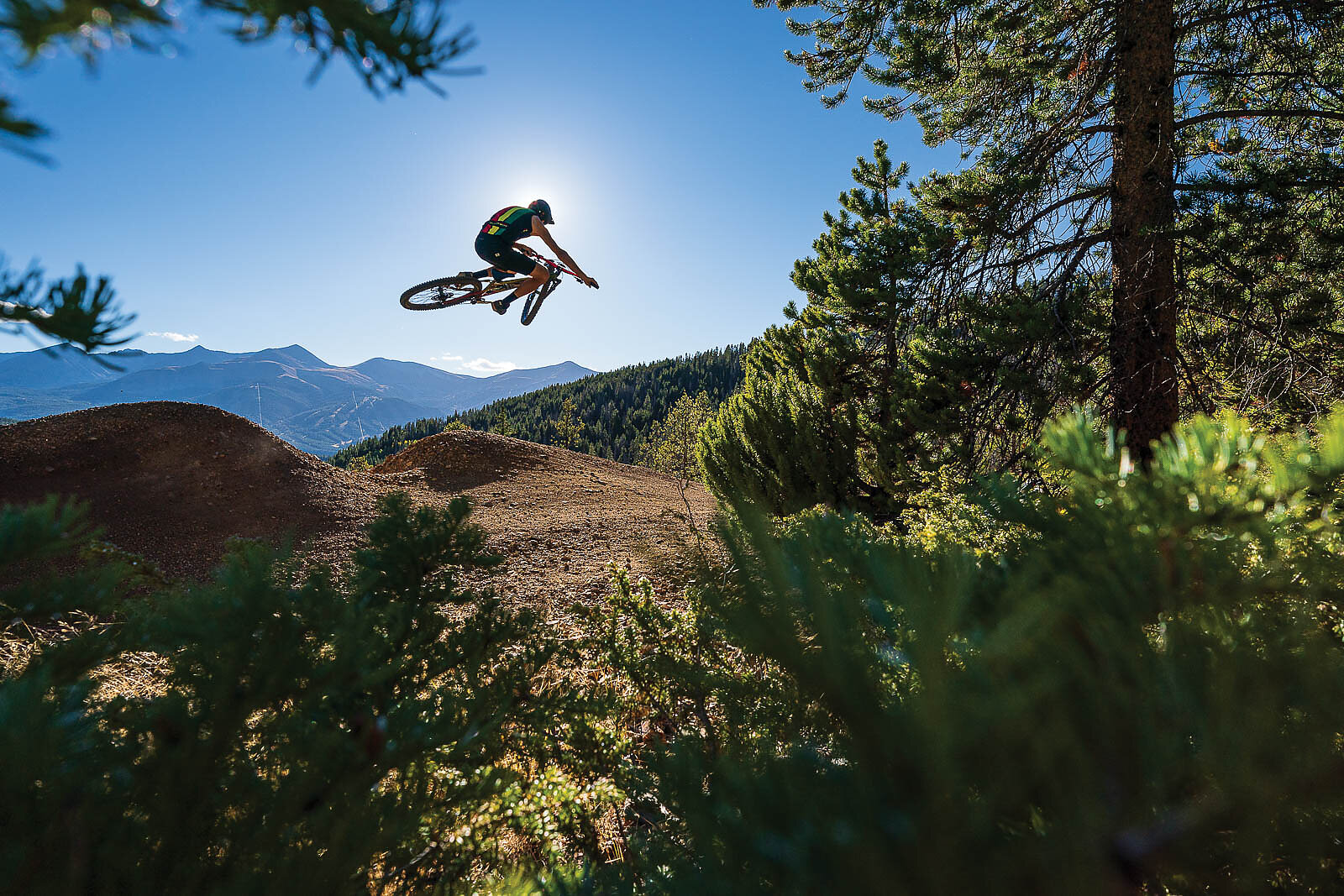
“Yeah, this place is a pain in the ass when it’s crowded,” Hills concedes. “But when people bash it, I just smile. There are always hidden gems where you can poke around and avoid the people if you try a little harder and get a little higher.”
Double-entendre jokes aside, getting higher is not just an ambition. For many around here, it’s a necessity. Later this evening, Hills will push his bike up a gnarly dirt road to ride a section of the Continental Divide Trail that most through-hikers (and mountain bikers) skip. For as much as he enjoys jumps and flow, so too does he seek out solitude and suffering.
“The beauty of Colorado is you do kind of have everything,” Hills says. “But I think the crown jewel is the alpine stuff, this time of year in particular. Just the massive elevation gain you can get. There’s no roly-poly shit. It’s: do a huge climb, then do a huge descent, and that, to me, is more of a reward. I’d rather climb for a couple hours then have a mega downhill, than go up for five minutes then down for five minutes.”
It also helps that there are still plenty of quiet trails weaving through the forest that the digital map makers haven’t quite gotten to yet.
Breckenridge has always been the local network’s nucleus, and it didn’t happen by accident. Though most towns got their start from mining, Breckenridge was the hub—an 1859 gold-nugget motherlode that attracted thousands of prospectors over the years. Their dreams live on through a mesmerizing web of old cart roads, footpaths, flumes, and aqueducts that serve as the anchors to the modern singletrack playground.
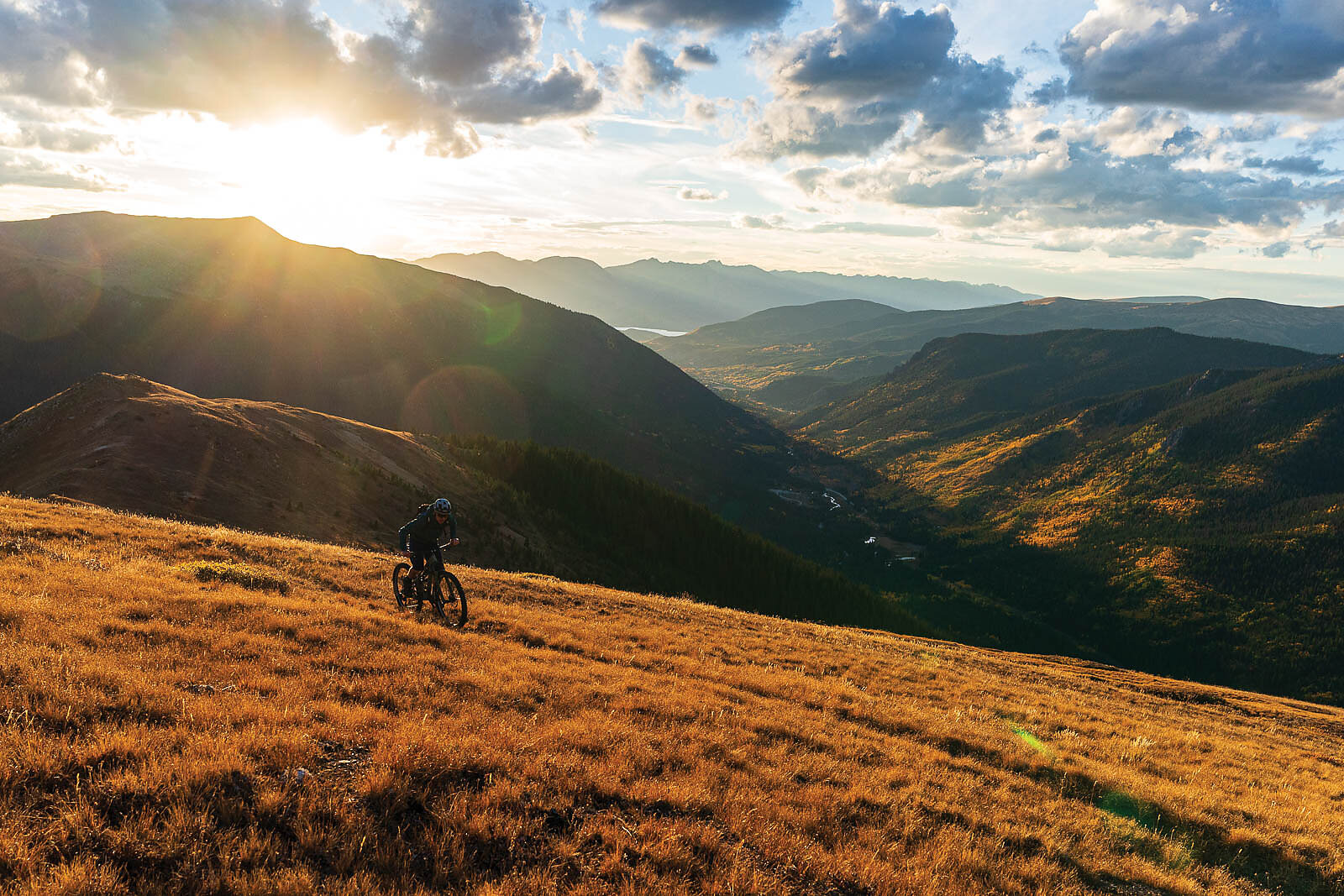
“I have seen Olympians and some of the fittest people in the world come apart at the seams on that climb like it’s their first day on the bike.”
—NATE HILLS
Access, however, was a different story. An enterprising local rider named Laura Rossetter helped bridge the bygone era to the modern development rush. After publishing a guidebook in 1989, Rossetter was hired by Summit County and the Town of Breckenridge a few years later to document every social trail in the watershed so that if the time came to argue for their preservation in the face of new subdivisions, there would be a record of each one’s existence. It took two years of calling owners and walking the land, but she got to know the network like no one else—and laid the groundwork for what would become a crucial master plan.
“The whole impetus for the inventory was that trails started to become threatened, and people were worried they were going to have to drive to trailheads,” Rossetter says.
She went on to help build some of the area’s backbone routes and still serves on Summit County’s Open Space Advisory Council. One year on the Lower Flume, she recalls, her labor came from prisoners at the jail.
“I go, ‘Hey guys, here’s our work. We’re gonna pull this gravel over here and build a turnpike,’” she says with a grin. “And they go, ‘We have to work?’ I said, ‘Well, yeah!’ ‘Well, can we just go back to the jail?’ It was like working with kindergarteners. They were so unhappy with me because I made them haul wheelbarrows.”
Though it was often an uphill battle to get developers to see trails as worthwhile, sometimes they didn’t have a choice, and even those who protested usually came around. In 1990, the Breckenridge Fat Tire Society was formed to preserve access to a popular town trail called Moonstone, setting another key precedent (the organization was later renamed the Summit Fat Tire Society as its scope expanded, and it’s now known as the Summit County Mountain Bike Alliance, or SCoMBA).
Major events further established the town: Breckenridge has hosted the Firecracker 50, an iconic Fourth of July race which doubled as the national marathon championship, since 2001, and the six-day Breck Epic stage race since 2009. Additionally, the now-defunct Breckenridge 100 ran for 11 years starting in 2005. Thanks to the county’s perch on the continent’s spine, competitors in the annual Tour Divide race from Canada to Mexico pedal down Main Street every year.
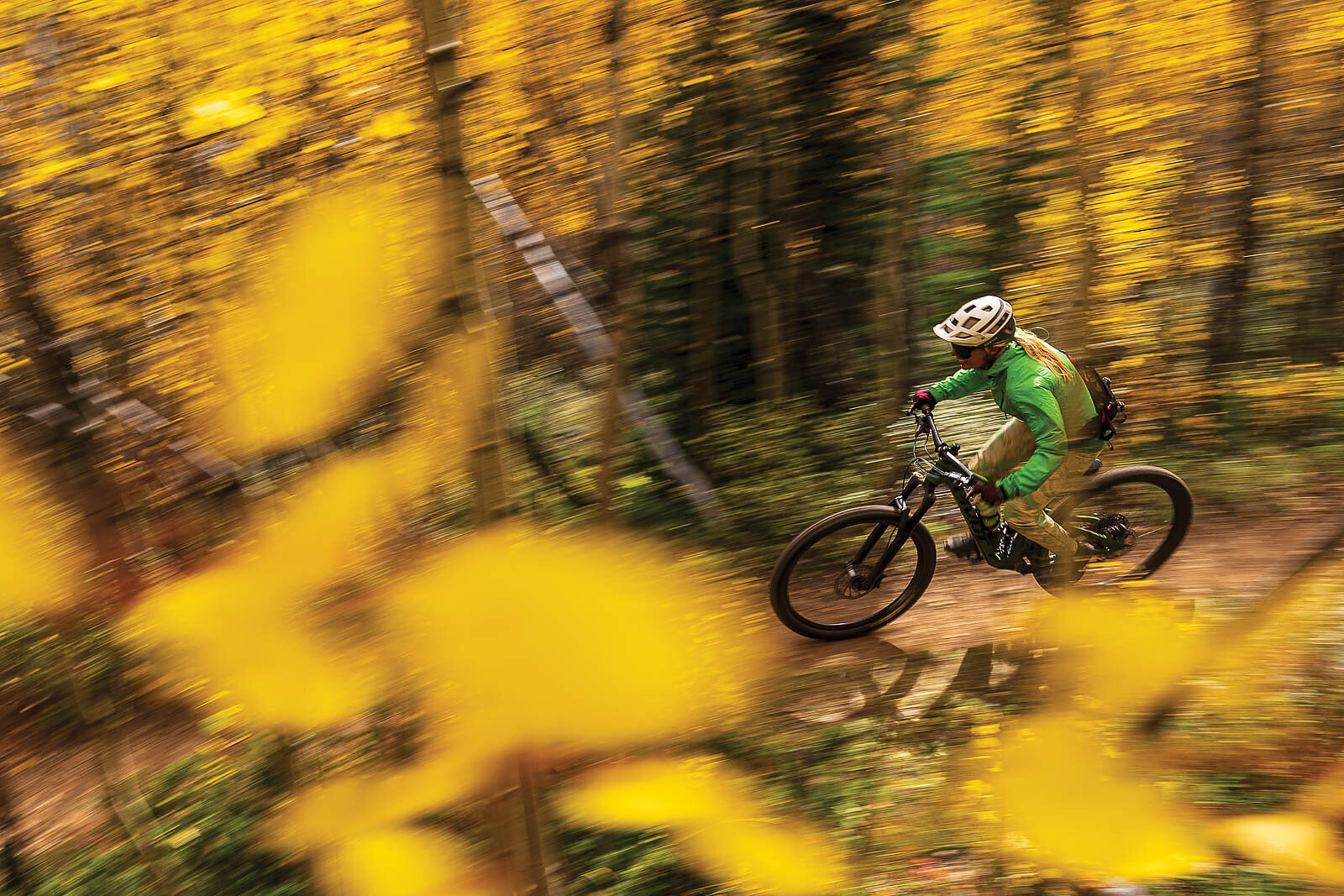
It all happens against a backdrop of progressive construction and colorful culture that adds to the destination’s allure among core riders. The town builds about three new miles of trail each year, partnering with organizations like SCoMBA and the U.S. Forest Service and Great Outdoors Colorado. A half-percent sales tax that voters passed in 1996 generates around $4 million annually for open space, three-quarters of which is allocated for new land acquisitions. The rest helps to fund one of the best trail crews in the state. There are more than 500 portal posts marking trail junctions in Breckenridge, and every residence in town is less than a quarter of a mile from an access point.
Lately, the bounty has come to include more freeride trails, such as the reimagining of Side Door in French Gulch, one of the premier riding zones. Four years ago, using an old mining road as a central corridor, the town added crisscrossing jump lines to the left and right, above and below the road itself, all built into the mountain as the trail weaves through an aspen grove.
The rest of Summit County also boasts plenty of heft, especially when it comes to alpine riding. The Wheeler National Recreation Trail, which begins just north of 14,265-foot-tall Quandary Peak and ends near Copper Mountain, is often ridden in tandem with the Miners Creek Trail (which doubles as the Colorado and Continental Divide trails over the Tenmile Range). If you start in Breckenridge and finish with the Peaks Trail, you reach 12,300 feet three times, all on singletrack, for a 25-mile loop that feels like 50.
Other local biggies (and Colorado Trail overlaps) include Searle Pass from Copper and the revered Circumnavigation of Mt. Guyot—a loop around the namesake 13,370-foot-high peak east of Breckenridge that crosses the Divide twice and features a pair of drool-inducing descents, off of French and Georgia passes. Some rudimentary navigation online can steer you toward the Great Flume to complete the circuit, one of the coolest old mining trails you’ll ever ride.
Farther east, another classic awaits in the Lenawee Trail off the backside of Arapahoe Basin Ski Area. Once a hallmark of the Montezuma’s Revenge 24-hour race, Lenawee remains one of the most spectacular—and exposed—routes in the county. Some elect to shuttle it, but doing so requires more planning and petrol than it’s often worth. The more traditional ride starts with a brutal, 1,700-foot dirt road climb up the ski area’s north side before bombing into Peru Creek—a timeless test of fitness at elevation.
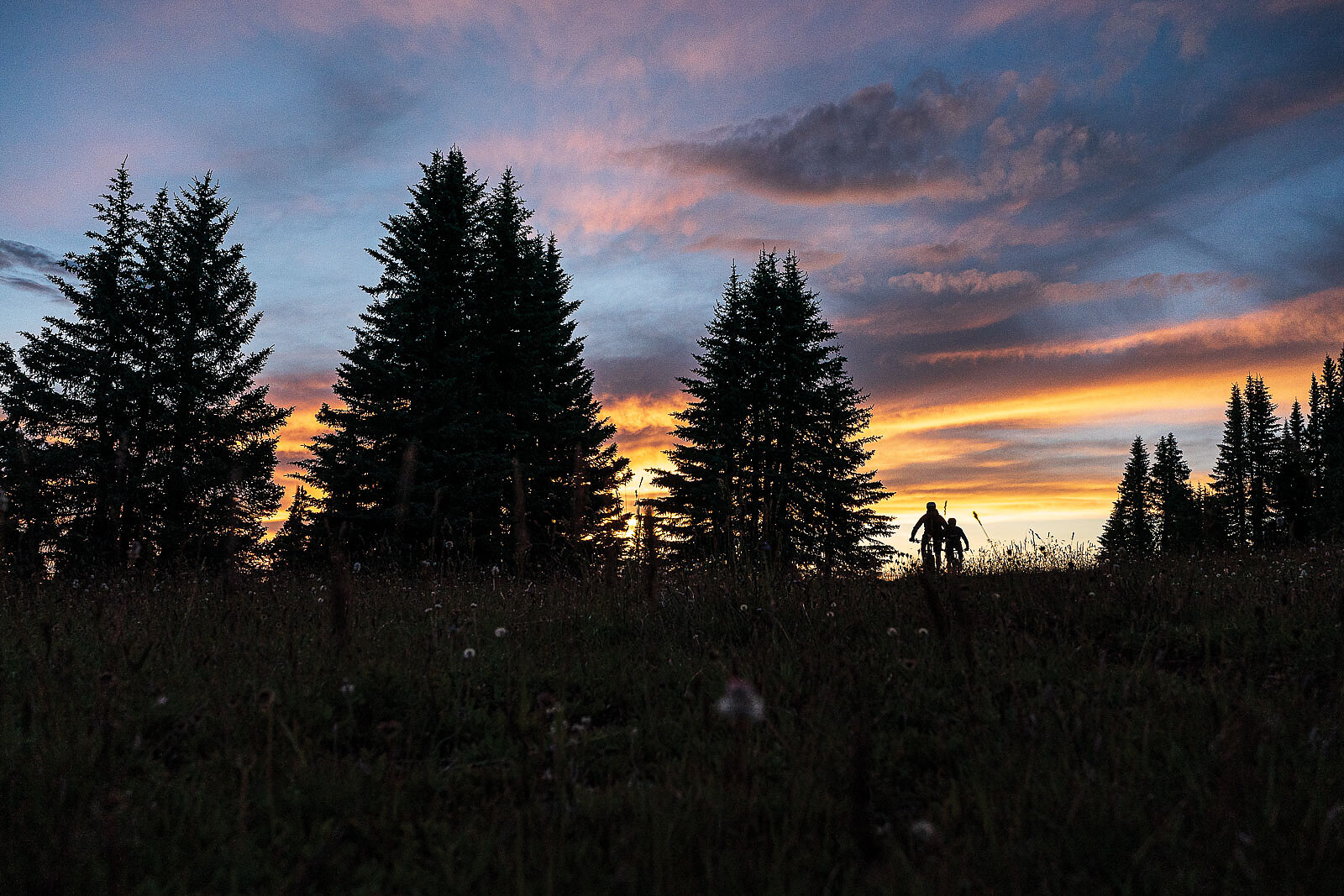
“You basically get out of the car at 10,700 feet, and there’s no warmup—you just go straight up,” Hills says. “I have seen Olympians and some of the fittest people in the world come apart at the seams on that climb like it’s their first day on the bike because their aerobic capacity just isn’t the same. Watching them push and walk and say, ‘Man, this is hard,’ is kind of funny. They’re not just humbled by the exertion, but also the surroundings and exposure.”
The county’s newest alpine attraction also happens to be at Arapahoe Basin, where longtime IMBA trailbuilder (and former A-Basin night janitor) Joey Klein is almost finished crafting a new 10-mile, non-lift-served trail called the Beavers Loop that weaves its way down the north face. And, of course, local gravity fiends also have at their disposal one of the state’s gnarliest lift-served bike parks high on Keystone Resort.
Summit’s neighbor to the west, Eagle County, home to Vail, may not be as well known for its riding, but that says more about Summit than Eagle. If you’ve spent enough time in these parts, you know that Bowman’s Shortcut off of Vail Pass accesses two of the area’s most ripping rides: Two Elk and Two Elk East. The former, which snakes across Vail’s iconic Back Bowls, is hard to top during prime wildflower season. There’s also a legit (and usually empty) bike park on Vail Mountain, otherworldly foliage riding at Beaver Creek in autumn, and trails up and down the valley on both the north and south sides.
Like many Colorado communities, Eagle County benefits from strong advocacy organizations, including the Vail Valley Mountain Trails Alliance, led by the area’s singletrack godfather, Lee Rimel, and co-founder/president Jamie Malin, who built a volunteer army of 1,000 over a decade; as well as the Hardscrabble Trails Coalition, which stewards everything down valley around Eagle and Gypsum, popular lower-elevation riding zones a half hour west of Vail that absorb the swarm of jonesers in spring.

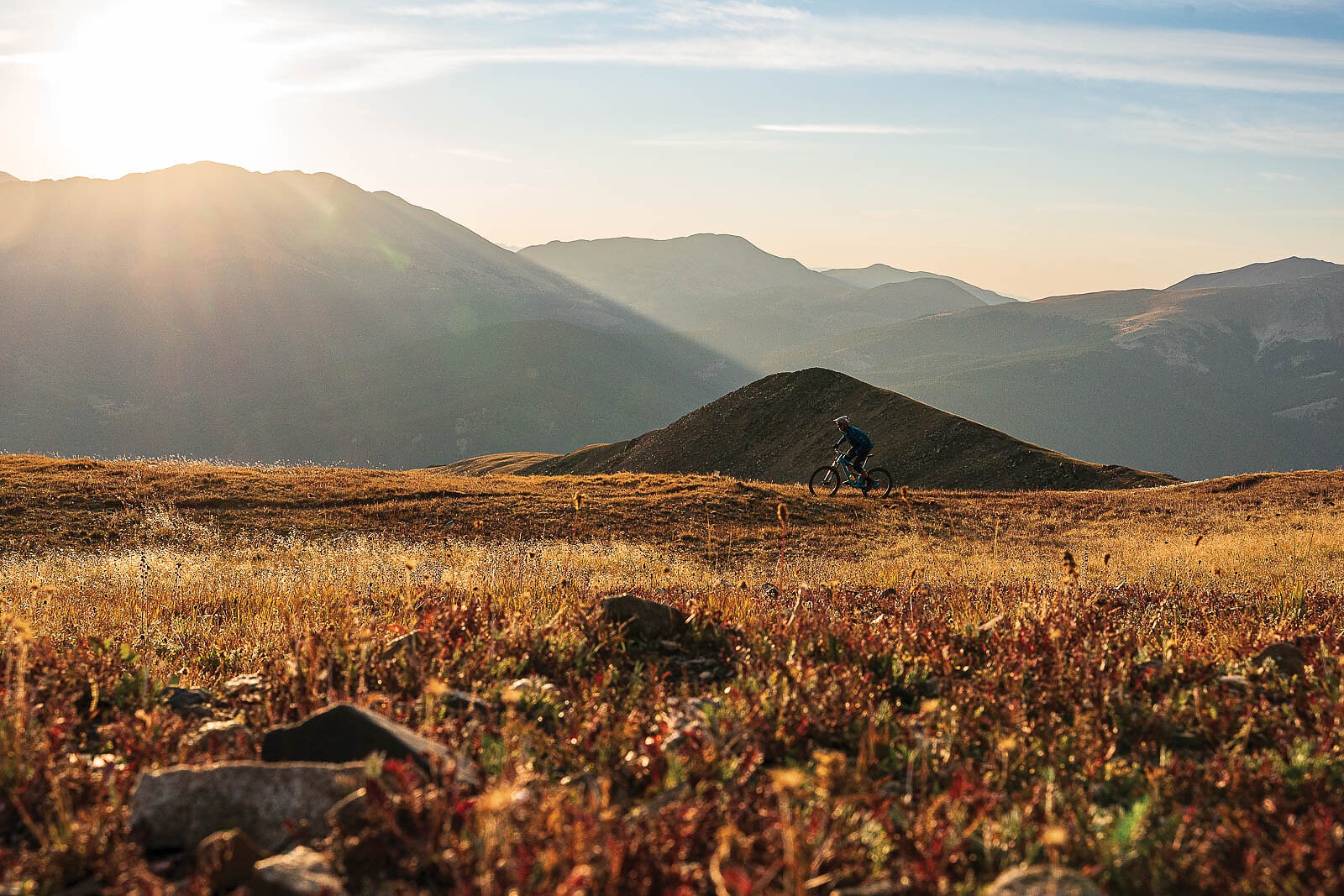
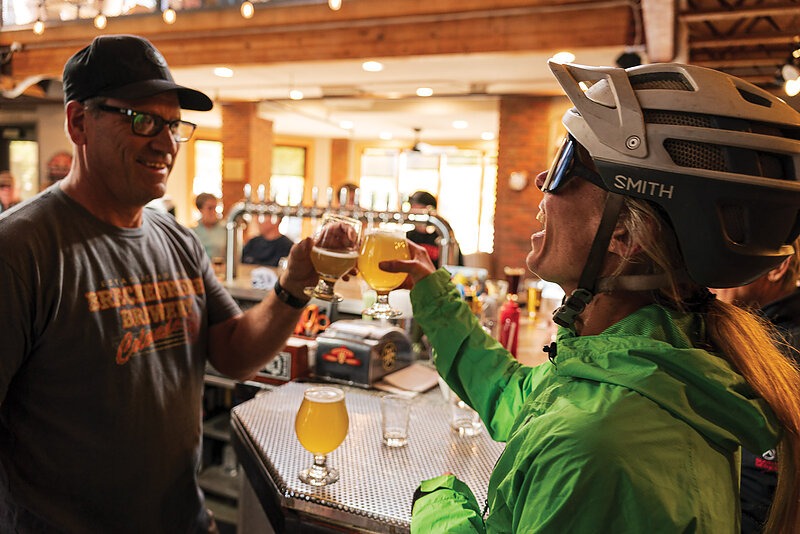
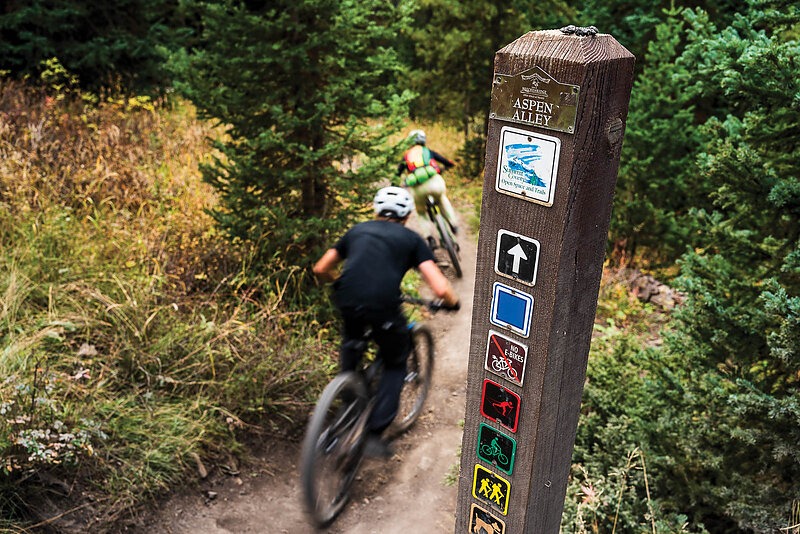
The same can be said for Chaffee County, an hour south of Summit and Eagle. Anchored by Banana Belt towns Salida and Buena Vista, as well as the world-class shuttles around Monarch Pass, the Arkansas River valley has grown to be a destination unto itself. Salida, an 1880s railroad depot, remains the cultural core.
Its 330 days of sunshine and rattler-friendly climate made it a perfect place for mountain bike pioneers Mike Rust and Don McClung to open their shop, Colorado Cyclery, during the sport’s nascent heyday. McClung, a former motorcycle racer from Terre Haute, Indiana, went on to become a well-known fabricator and mentor to dozens of “Don’s Disciples” who saw similar potential in the town’s backcountry.
“He and Mike made Salida mountain biking what it is,” says longtime local Nathan Ward, whose 2015 film The Rider and the Wolf chronicled the Hall of Famer Rust’s disappearance and murder during a robbery gone wrong.
In 2004, Ward and a small cadre of hardy locals founded Salida Mountain Trails (SMT), a volunteer advocacy group that took the town’s riding to another level. Part of their magic is that they worked with four land managers to build it: the City of Salida, the U.S. Forest Service, Colorado State Parks and the Bureau of Land Management. They converted a dumping ground above the river into one of the best easy-access hubs in Colorado—the Arkansas Hills trail network—with a web of purpose-built trails that fill the piñon forest around Tenderfoot Mountain. That quick-fix menu (along with its Old 96er component, the dreamy, hour-long Cottonwood descent) is complemented by the Methodist Mountain trails to the south and rowdier options like the Green’s, Fooses, Agate, and Canyon creek descents off Monarch Pass, 25 minutes up Highway 50—all absolute hell rides. An unsanctioned yet hotly contested overnight race, the Vapor Trail 125, combines much of the area’s best riding every August; last year 21 soloists finished.
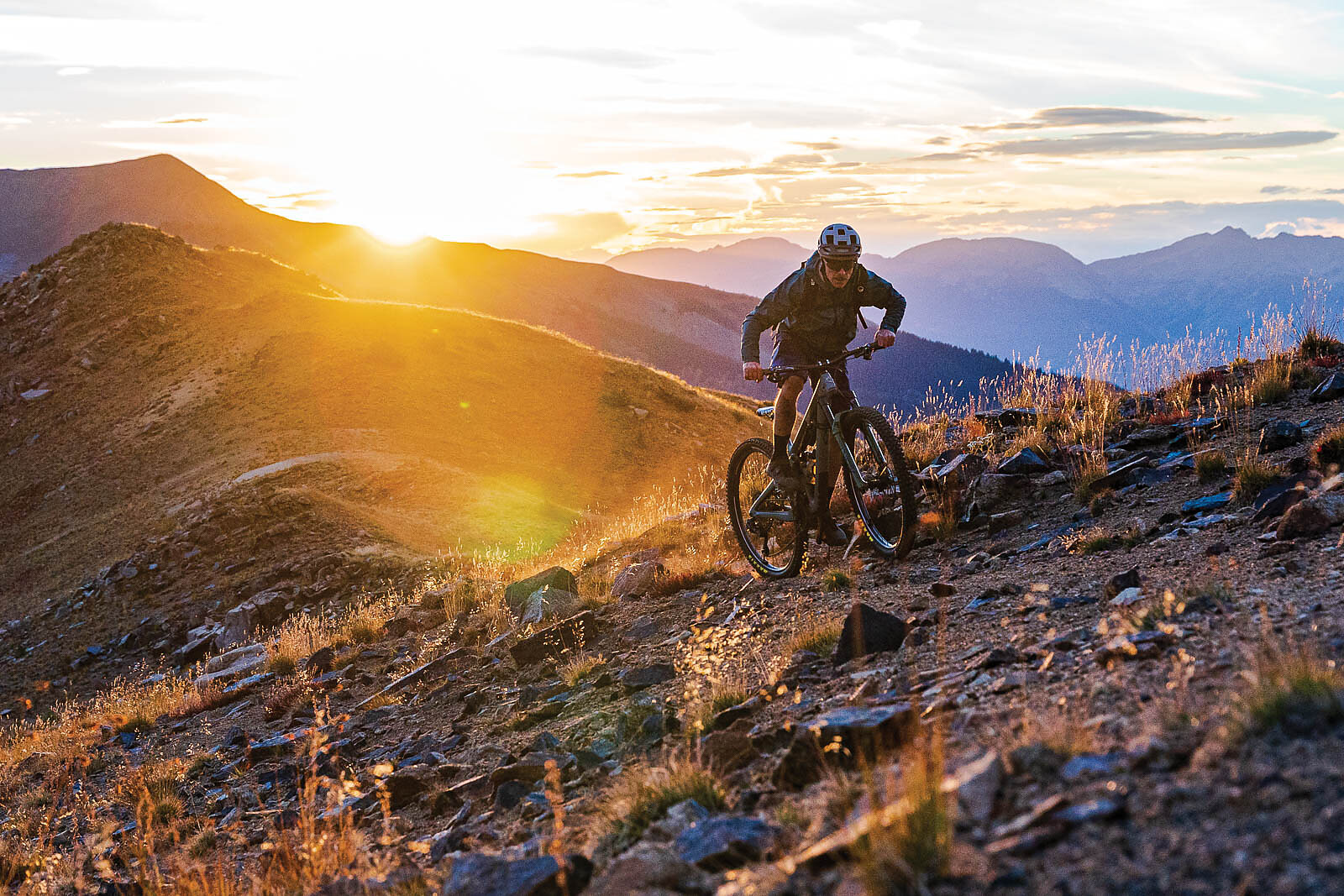
The network around Buena Vista, a half-hour north of Salida, is less robust but still plenty worthy, with trademarks like Vitamin B. And, a half hour north of Buena Vista you’ll find one of Colorado’s true novelties: a bike-legal trail to the summit of 14,440-foot Mount Elbert, the highest peak in the Rocky Mountains. The trail was re-routed a few years ago, making it possible to ride about 80 percent of the 5,000-foot ascent. Theoretically, you could do it with one (very low) gear since you don’t touch your shifter on the descent.
Chaffee County’s trail system continues to evolve in progressive ways, a trend that permeates the region and state as a whole. Much of it comes down to the builders and their personal riding styles. Take, for example, Breckenridge open space and trails operations supervisor Tony Overlock. He started as a seasonal digger in 2005, and you could argue that no one has had a more direct role in expanding the town’s network since then. A soft spoken New Englander who grew up riding snowmobile corridors in Maine, Overlock doesn’t like to ride lame trails, so they don’t get built—even the green runs are swoopy and fun.
The same can be said of Troy Heflin, owner of Higher Ground Earthworks, who does most of the town’s machine work. He’s a former pro downhiller who has worked with excavators since he was a kid. “I think the level of our trail design and what we’re creating is so elevated from what we used to do 10 years ago,” Overlock says. “It’s incredible what you can sculpt and shape out of old tailings piles and ditches to be able to build these awesome freeride trails.”
No line exemplifies that—or the reason why the network is so stout in the first place—like Hard Luck, a machine-built joyride that snakes through the trees in the Golden Horseshoe northeast of Breckenridge’s toniest neighborhood, the Highlands. The short but radical trail, wedged between Fall Classic and the Upper Flume, crosses town, county, and Forest Service land, which presented a unique challenge for Overlock and his crew when designing it—even though they regularly build on all three agencies’ land. The feds didn’t want anything that carried much risk on their portion, so with only about 2,800 linear feet to work with, the descent had to thread some needles.
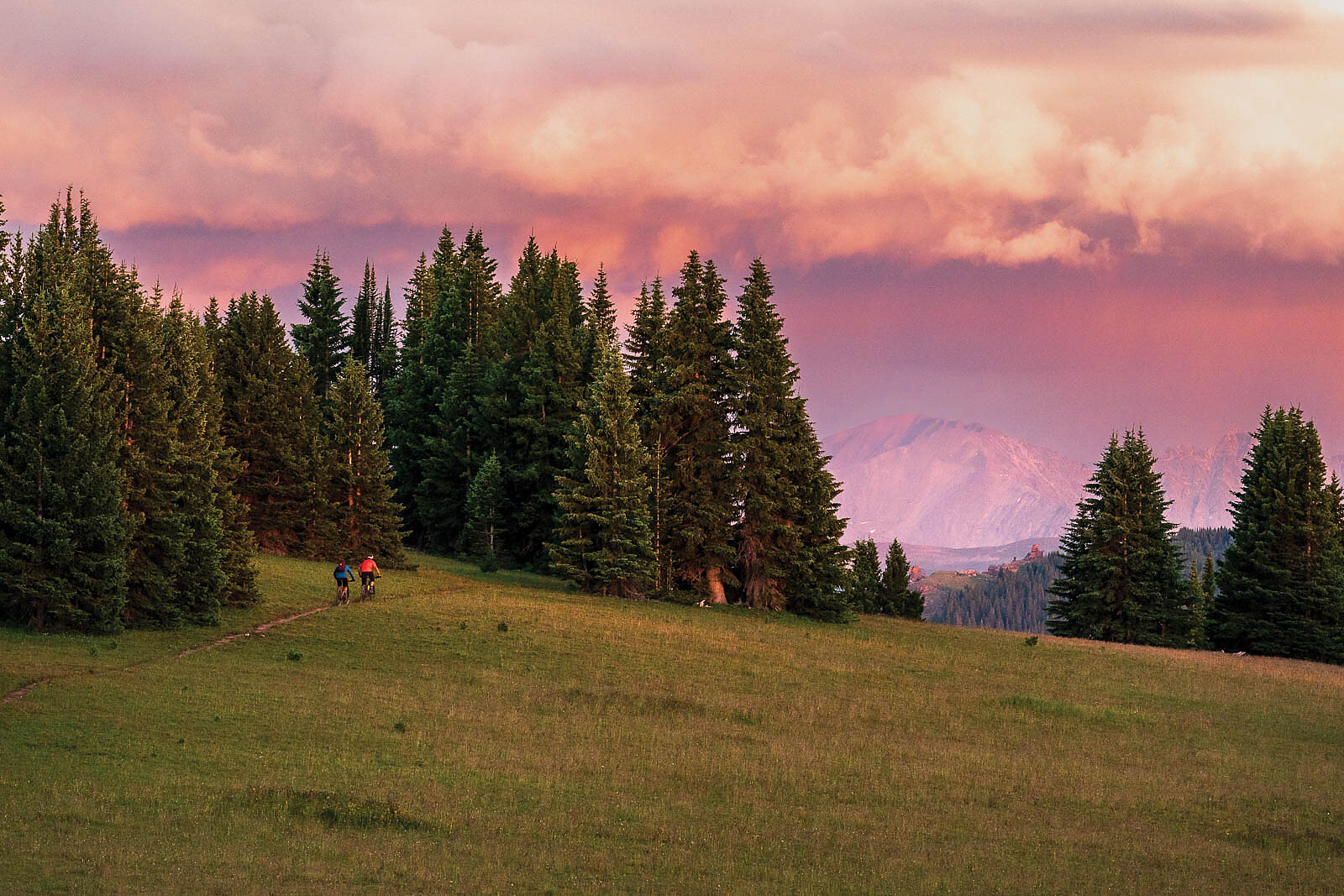
“The Forest Service’s liability and willingness to commit to it was, Yes, we understand that you want to have a bike-recommended trail, but we want features to be low consequence and low to the ground,” Overlock says. “So we mainly built berms for those sections, then when we got on town and county land, we had a blank slate. That’s where you see the more aggressive jumps and tables and drops.”
Three years into its existence, Hard Luck has become a local favorite, incorporating 100-year-old mining features as takeoffs and landings and generally delivering a roller-coaster feel on north-facing dirt that stays perpetually tacky.
Collaboration remains a stamp of the Blue River watershed. SCoMBA often partners with the Summit County Off-Road Riders, a motorized group, to build or improve shared trails like the Tenderfoot zone near Dillon. There is rarely a time when you ride alpine trail that is not in perfect, if rugged, condition—a benefit to having nationally relevant singletrack and a reputation to uphold. Constant upkeep is what keeps it prime. Proximity is the supplemental luxury.
Hills once left his home in Summit Cove and rode south to the Colorado Trail, then up and over the Tenmile Range—twice—before taking the 3,000-foot Wheeler South descent into Breckenridge and eventually spinning back to Frisco to lap the dirt jumps until sunset, at which point he headed home. He was out for 12 hours and roughly 50 miles. Rides like that root him to the place.
“Ease of access is important to me,” Hills says. “Being able to literally open the door and start pedaling is a huge privilege. Most people don’t have that.”
Here, it’s hard to find anyone who doesn’t.
